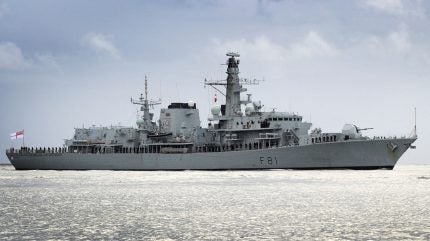
The disclosure by the UK government that one of its Type 23 frigates, HMS Sutherland, will soon return to operations after a four-year-long refit offers a slight fillip for a Royal Navy that is starved of surface combatants.
In a brief parliamentary written response, published on 28 January, Minister for Defence Procurement Maria Eagle stated that HMS Sutherland was “reaching the end” of its service life extension process.
“Once this is complete, [HMS Sutherland] will undertake a period of force generation and assurance ahead of assuming readiness for routine and contingent tasking,” Eagle said.
The Type 23 frigate was notably revealed in February 2024 to have required 600 structural inserts during drydock as part of its extensive upkeep programme carried out at Babcock’s Royal Naval Dockyard inside HMNB Devonport.
However, this sizeable total of inserts is still short of the 1,000 needed for HMS Iron Duke during its own life extension process.
Structural inserts typically remove degraded or rusted sections of hull or the ship’s superstructure, ranging in size from a small hand-sized plate to large panels.
Arriving on-site in April 2021, HMS Sutherland was intended to be delivered back to the Royal Navy in the Q3/Q4 2024 timeframe. Among works carried out include the installation of four new diesel engines under the Power Generation Machinery Upgrade (PGMU) programme, as well as and other upgrades and rectification work.
According to the Royal Navy, Sutherland is the last ship in its class to go through the overhaul, which extends the life of the frigates to allow them to continue in service into the mid-2030s.
It is planned that HMS Sutherland itself will operate until 2032 when it will be replaced in its anti-submarine role by a Type 26 frigate, possibly fifth-in-class HMS Sheffield.
Despite this, the Royal Navy is at an all-time low, with just eight frigates left in its major surface combatant force following sustained cuts by consecutive Conservative and Labour governments and delays to replacement ships. The service’s frigate fleet will drop to just seven hulls later in 2025.
Why are the Type 23 frigates difficult to maintain?
Previously reported by Naval Technology, the length of time a Type 23 frigate has been spending in refit programmes is increasing, as the fleet ages and becomes more difficult to maintain. Each ship of the class was originally intended to have an 18-year service life before replacement, but this has been extended.
From 2011-2017 each of the then 13 Type 23 frigates underwent a LIFEX or refit period, with the duration of each programme ranging from 12 months up to 36 months. From 2018 onwards this increased, with the first three vessels to undergo earlier work returned to the shipyards for between 37-49 months.
In line with vessel class certification rules, the out-of-service date of warships can be extended for a maximum of six years following completion of each upkeep maintenance programme. This points to HMS Sutherland being certified to remain operational until the 2031 timeframe, slightly ahead of its current planned out-of-service date.
The cost to refit and maintain the ageing class is also a factor, with HMS Iron Duke’s 2023 refit costing more than £100m ($125m). By comparison, in the financial year 2023-24, £100m was allocated for Type 23 refits, according to official figures.
In April 2024 Babcock took over full upkeep requirements for the Type 23 frigates following the award of a contract to manage the type’s operational availability, requiring the company to take end-to-end responsibility for maintenance and regeneration.







